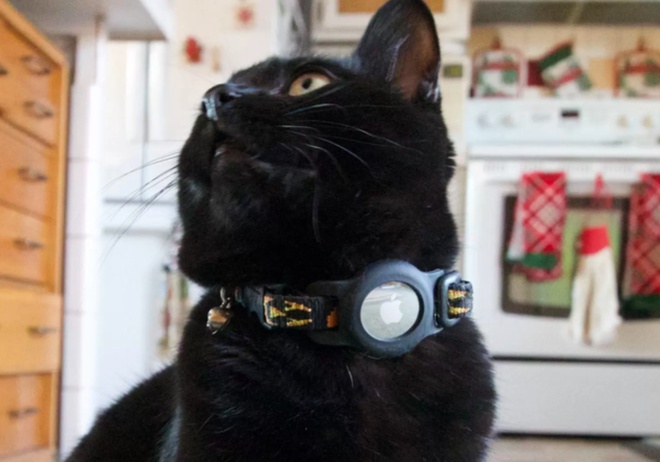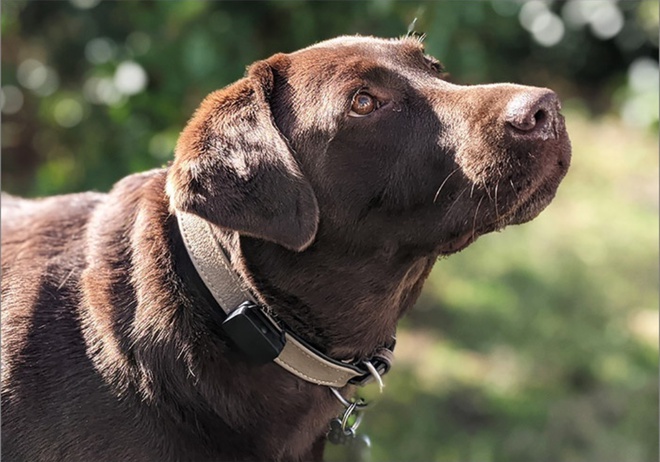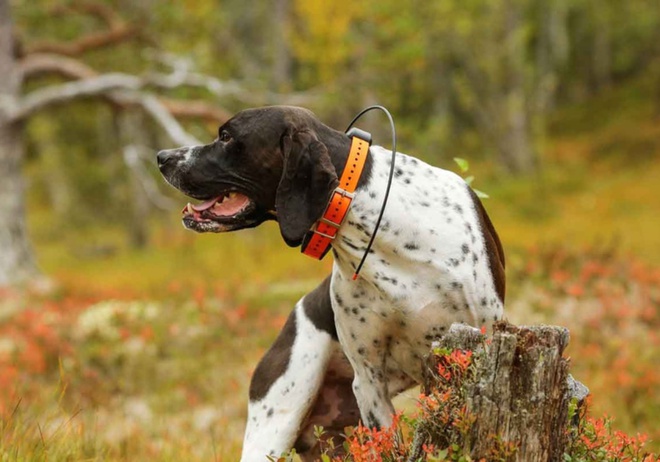How to choose the best GPS tracker for pets without subscription
Choosing between all the GPS collars out there is no easy task. This article gives you an overview of the different no subscription technologies available, as well as looking at their strengths and weaknesses.

Reading time : 7 min
It's vital to choose the right GPS tracker for your dog or cat, as it plays a key role in their safety. So how do you choose the best no subscription GPS tracker collar for your pet? Get the facts in this article about the different technologies that allow no subscription tracking, their advantages and disadvantages, and above all whether they are the best choice for pets.
SUMMARY
A Bluetooth tracker for dogs and cats

A key finder started out as a quick and easy way to locate an everyday item like your keys or a wallet. Over time, people started using them to find all sorts of things, with some now attaching a key finder to their cat or dog's collar. But is that such a good idea?
Bluetooth technology
A key finder is a tracking device that uses Bluetooth technology to provide location information up to 50 metres away (in ideal conditions: open environment). The manufacturers of Bluetooth GPS devices have now introduced Crowd GPS. This means that the signal, which used to be limited to a maximum distance of 50 metres, can now be extended using the community of smartphones in the immediate vicinity of the tracker. The tracker will use the position of another device nearby (usually a mobile phone) to update its location, allowing for longer range tracking.
Advantages and disadvantages
This type of tracker will allow you to locate your pet very accurately at close range and indoors. It's also fairly cheap, costing around £30, and the battery will last for about a year. Plus, its small size makes it an attractive option for cats and dogs.
On the other hand, finding anything more than 50 metres away can be tricky as you're dependent on the size of the community around the tracker. So in rural or sparsely populated areas, this type of technology will work less effectively or even not at all. What's more, crowd GPS only works if the person passing by has both their GPS and Bluetooth turned on. Last but not least, you won't be able to track your pet in real time, so you won’t be able to find them unless they sit still (which, let’s face it, is highly unlikely).
As you can see, this type of device really isn't a good option for tracking a pet. A different technology would be a safer solution.
Brand examples
One of the best known Bluetooth trackers is, of course, the Apple Airtag. It has the disadvantage of not having a specific attachment, so you would have to buy an (expensive) accessory to attach it to your pet's collar. The brand itself states that it is not suitable for tracking animals.
There's also the American company Tile, which specialises in this type of tracker and offers a cheaper alternative to the Apple version.
Low power GPS trackers for dogs and cats

Sigfox and Lora networks
The Sigfox and Lora networks were created a few years ago specifically to keep up with the rapid increase of smart devices and the Internet of Things. They use public frequencies that allow manufacturers to reduce their costs, as they are free to use. This is how they can offer a service without a subscription, or with a subscription included in the price of the tracker.
Advantages and disadvantages
The main advantage of this kind of tracker, apart from the fact they don't need a subscription, is their battery life. The battery will usually last for at least several days, if not weeks. Unlike Bluetooth trackers, they work over an unlimited distance. On top of this, they are autonomous, as they fetch their own GPS position.
On the other hand, the fact that they use open, public frequencies creates a delay in message transmission, due to network saturation. The limited number of daily messages (to avoid saturation) also hinders real-time tracking, as you won't have as many positions as you need in a given period of time (e.g. only 5 positions in one hour).
Real-time tracking is only possible if the messages sent by the tracker are transmitted every 5 to 10 seconds. With a limited number of messages per day and these networks being regularly saturated, real-time tracking is difficult if not completely impossible. If you’ve lost your pet, time is of the essence and you don't need anything that makes your search harder.
Consequently, this type of tracker isn't suitable for tracking a dog or cat either. Again, a different technology would be a safer solution.
Brand examples
Very few brands use these networks for tracking pets, as they're not really suitable. One example though is the French company Invoxia, whose trackers are actually better suited to tracking a car or finding a bike.
There used to be other brands too, but they gradually fell by the wayside as they weren't up to the job of keeping pets safe.
Things to check before buying a GPS
18 questions you need to ask yourself before buying a GPS tracker for your loved ones!
Radio tracking collar for dogs

Radio frequency
Finding your lost dog with a GPS tracker without subscription is also possible using radio frequencies. As a matter of fact, Garmin products are very popular with hunters who need to find their dogs in dense forests and/or in areas with more dead zones, for example. These radio frequency devices work using a transmitter collar and a GPS receiver, just like a walkie-talkie.
Advantages and disadvantages
The main advantage of this type of technology is that it allows for unlimited real-time tracking, which is a huge advantage when compared with the two technologies we looked at earlier in this article. Using a radio frequency also means that you're not dependent on conventional mobile phone networks. So there's no risk of being cut off in a dead zone. This explains their widespread popularity in dense woodland, especially for hunting.
On the other hand, this type of tracking collar only has a range of a few miles. Beyond that, the signal is lost and it becomes impossible to find the dog. This type of tracker only allows a single user (whoever has the receiver), which can be problematic in a family. Lastly, they are very expensive (almost prohibitively so), costing around £750 for just one device. These collars don't have any other features apart from tracking, like an escape alert for example.
While radio tracking collars are suitable for specific uses in woodland, they are far less suitable for more normal use like keeping your pup safe on their daily walks. They also won’t help deal with your dog running away. As for cats, their size and weight makes them completely unsuitable for our feline friends.
Brand examples
The most popular brands of radio tracking collars include Garmin, Sportdog and Dogtra. These brands are all geared towards hunting, with products costing several hundred pounds. There used to be mass-market brands selling this type of tracer, but unfortunately this is no longer the case.
A GPS collar with subscription for your cats and dogs

Lost pets have a tendency to panic and their owners are understandably often very distressed. Finding a living creature is challenging but not impossible. There’s a lot to think about: the fact that an animal will be constantly on the move, it might run a long way, it could even end up miles away...
A GPS tracker is a must to be able to find your beloved pet. But it has to be foolproof. It has to be a GPS tracker with subscription; read on to find out why.
Real-time tracking
To find your pet quickly and easily, you need to be able to track them in real time. Unfortunately, as we saw earlier in this article, GPS trackers without subscription don't offer proper real-time tracking. The exception to this is radio devices, but they have too many drawbacks, including their price and range.
Real-time tracking is the most important factor in finding your lost dog or cat. Your pet will probably be frightened and totally disoriented. They will keep moving in the hope of finding shelter or making their way home. Having an updated position as often as possible is crucial.
GPS trackers with subscription are sold with a SIM card included. This SIM card keeps you continually connected to the manufacturer's server and allows you to send unlimited messages. This guarantees the best possible real-time tracking.
An unlimited tracking distance
GPS trackers with subscription are autonomous and transmit their position independently. This is in contrast to a Bluetooth tracker, for example.
As long as there is a mobile phone network, the tracker will transmit its position continuously all over the country and often even abroad (handy if you live near a border for example, or take your pet on holiday). This is exactly what manufacturers of GPS trackers for cats and dogs with subscription are offering.
What's more, coverage is often multi-network, which helps minimise the impact of dead zones on the performance of the GPS collar. You’ll always be able to find your pet, wherever they are.
Additional features
GPS trackers with subscription often include some very useful additional features. These may include an escape alert, or ring and vibrate features to help your pet with recall training. This can be a very effective tool for training your cat or dog, and for getting them to come back to you if they wander off too far.
Conclusion
Finding an object, a car, or a pet are completely different things. Each of these situations requires a specific type of technology. To choose the best product for your needs, first off you need to decide what you want to use it for.
Dogs and cats are members of the family and deserve a tracker that offers complete peace of mind. It’s absolutely vital to have real-time tracking AND an unlimited range. Only products with a subscription tick both these boxes. A GPS tracker without subscription is consequently not suitable for pets.
Continue reading our guide
This article is part of a complete guide on the subject. Do not miss the next chapters.
Are you looking for the best GPS tracker ?
18 questions you need to ask yourself before buying a GPS tracker


